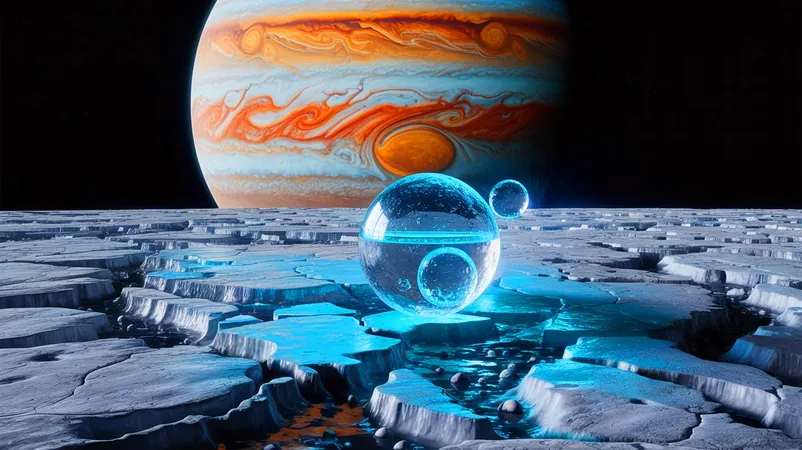
“Deeply Unsettling” Signals from Europa: What the Webb Telescope Discovered Could Change Everything
2025-07-27
Author: Ming
Europa's Astonishing Discovery Surfaces
In the heart of our solar system, Jupiter’s moon Europa has always captivated scientists with its potential to hide life beneath its icy crust. A groundbreaking observation by the James Webb Space Telescope (JWST) has taken this fascination to new heights, revealing unexpected levels of hydrogen peroxide on Europa’s surface. This revelation has sent researchers at the Southwest Research Institute (SWRI) racing to decipher what these findings mean for the moon's ability to support life.
Cracking the Code of Hydrogen Peroxide on Europa
To tackle the mystery of hydrogen peroxide's odd concentrations, SWRI has launched an innovative series of experiments. The initiative was sparked by bewildering observations highlighted by Bereket Mamo, a graduate student involved in the project. With NASA's backing through a prestigious grant, Mamo and his team set up simulations that replicate Europa’s icy conditions, using mixtures of water ice and carbon dioxide.
By exposing this mixture to energetic electrons in a vacuum chamber, they successfully demonstrated how such conditions might actually elevate hydrogen peroxide levels—mirroring the JWST's initial discoveries. This remarkable finding suggests that even tiny amounts of carbon dioxide can play a significant role in generating hydrogen peroxide, potentially solving a long-standing enigma about the moon's surface chemistry.
Could Life Exist in Europa's Subsurface Ocean?
The implications of this research extend far beyond chemistry alone. Dr. Ujjwal Raut, a program manager at SWRI, points out that hydrogen peroxide and similar oxidants might create a chemical environment that could support biological life. These findings raise the tantalizing possibility that beneath Europa's frozen exterior lies a subsurface ocean where life could not only exist, but thrive.
Richard Cartwright from Johns Hopkins University emphasizes the astrobiological relevance of hydrogen peroxide, suggesting it could serve as a chemical energy source for extremophilic life forms—organisms on Earth that flourish in the most inhospitable environments, devoid of sunlight.
Advancing Our Search for Life Beyond Earth
This exploration ties in seamlessly with NASA’s Europa Clipper mission, poised to delve deeper into Europa’s habitability when it arrives in the Jovian system. The insights gleaned from SWRI’s experiments are not just academic; they foreshadow what we might uncover during future missions aimed at unraveling the moon’s captivating mysteries.
Innovative Techniques Illuminate Icy Mysteries
The experimental methods devised by the SWRI team have been pivotal in illuminating Europa’s enigmatic surface chemistry. By replicating extraterrestrial conditions right here on Earth, they have unlocked vital clues about not only Europa but also about other icy bodies in our solar system, like Ganymede and Enceladus.
Dr. Ben Teolis, a co-author of the study, underscores the importance of chemical energy in fostering habitable worlds. The interplay between carbon from the ocean depths and energy supplies from space could spawn compounds like hydrogen peroxide, creating energy reserves essential for life in dark, sunless realms.
What Lies Ahead in Europa Exploration?
As anticipation builds for the upcoming missions including the Europa Clipper and ESA’s JUICE spacecraft, SWRI’s latest findings pave the way for more in-depth exploration. Their research, recently published in the Planetary Science Journal, highlights the necessity of collaborative science in unlocking the enigmas of our solar system.
With every new discovery, the question looms larger: What other secrets linger beneath Europa’s icy veil, and how will they redefine our understanding of life in the universe? As we push forward in our quest for knowledge, the truth may soon be closer than we ever imagined.



 Brasil (PT)
Brasil (PT)
 Canada (EN)
Canada (EN)
 Chile (ES)
Chile (ES)
 Česko (CS)
Česko (CS)
 대한민국 (KO)
대한민국 (KO)
 España (ES)
España (ES)
 France (FR)
France (FR)
 Hong Kong (EN)
Hong Kong (EN)
 Italia (IT)
Italia (IT)
 日本 (JA)
日本 (JA)
 Magyarország (HU)
Magyarország (HU)
 Norge (NO)
Norge (NO)
 Polska (PL)
Polska (PL)
 Schweiz (DE)
Schweiz (DE)
 Singapore (EN)
Singapore (EN)
 Sverige (SV)
Sverige (SV)
 Suomi (FI)
Suomi (FI)
 Türkiye (TR)
Türkiye (TR)
 الإمارات العربية المتحدة (AR)
الإمارات العربية المتحدة (AR)